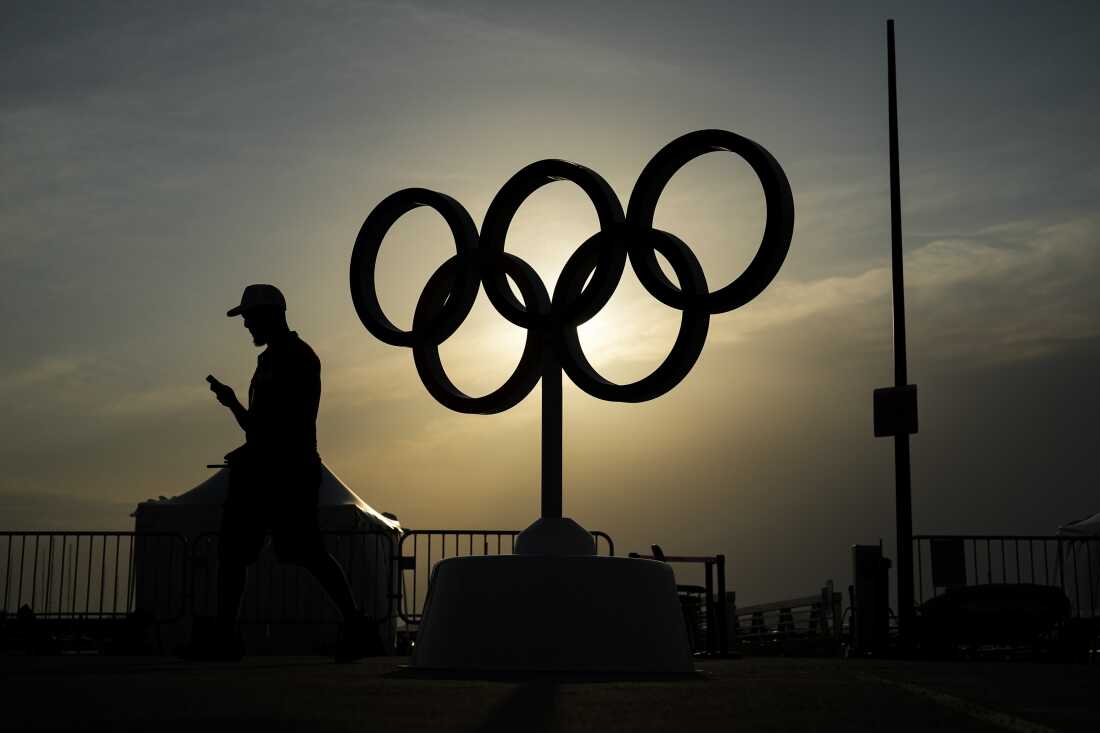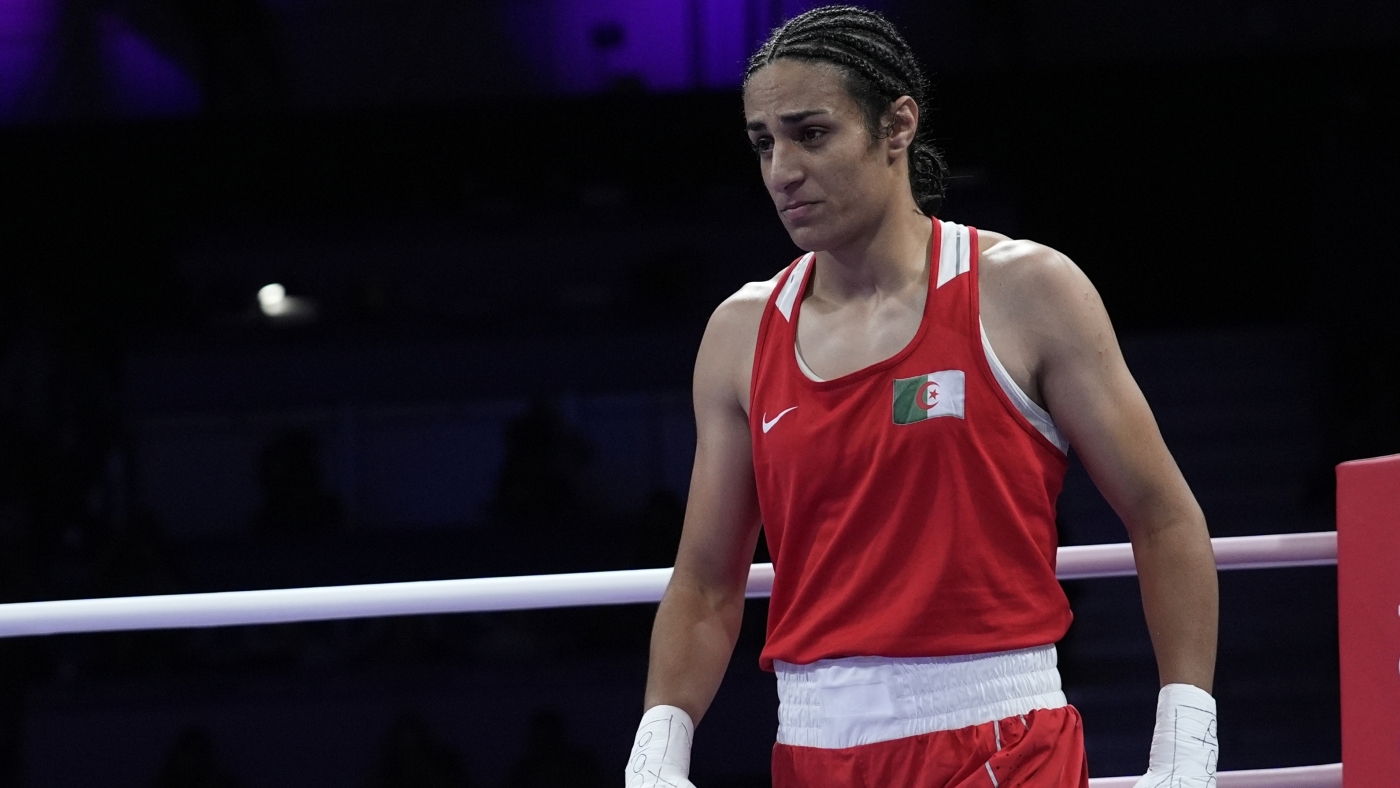Algeria’s Imane Khelif, reacts after defeating Italy’s Angela Carini in their women’s 66kg preliminary boxing match at the 2024 Summer Olympics, Thursday, in Paris.
John Locher/AP
hide caption
toggle caption
John Locher/AP
NPR is in Paris for the 2024 Summer Olympics. For more of our coverage from the Games, head to our latest updates.
Algerian Olympic boxer Imane Khelif is fighting more than just her Hungarian counterpart in the ring Saturday.
She’s now fighting to defend her career as a female athlete amid conservative accusations that she and Taiwan’s Lin Yu-ting are not women. Both athletes identify as women and have long competed in boxing as female athletes.
Questions arose after the International Boxing Association said both athletes were disqualified from the IBA’s 2023 world championships after failing eligibility tests.
It’s the latest controversy in a long history of female athletes being questioned over their sex.
“This whole spectacle is not unique to the Paris Olympics,” said Payoshni Mitra, the executive director of Humans of Sport, which supports athletes with sex variation.
Here’s a look at the current controversy and the history of sex testing.
A complicated question
Since women started competing in elite athletics about 100 years ago, they have been subjected to questions over their sex, had to undergo humiliating sex eligibility tests and had careers ruined.
Lin and Khelif’s case underscores how “women coming from global south countries are often the ones being targeted,” said Mitra.
The IBA said the tests indicated the two “were found to have competitive advantages over other female competitors.” The IBA did not respond to NPR’s questions and is not providing documentation of the tests.
Human rights advocates say these exams “discriminate against women on the basis of their sex, their sex characteristics, and their gender expression” and violate the right to privacy, dignity, health and non-discrimination, a 2020 report from Human Rights Watch said. Mitra was a co-author on this report.
For more about sex testing in elite women’s sports, check out the new podcast Tested, from NPR and the CBC.
Critics question the science behind them and say results can yield a complex answer.
“Over time, people have looked at genitalia, they’ve looked at chromosomes, they look for a specific gene, they’ve looked at testosterone. And what we end up with is the understanding that there’s really no clear cut definition of sex, because each of these iterations of testing has kind of collapsed under its own weight,” said Jaime Schultz, a professor with Penn State University’s department of kinesiology.

The sun sets behind the Olympic rings at the Olympic marina during the 2024 Summer Olympics, Friday, in Marseille, France.
Daniel Cole/AP
hide caption
toggle caption
Daniel Cole/AP
By the rules
International athletic federations are allowed to establish their own regulations when it comes to sex eligibility of athletes.
The International Olympic Committee said this week that all boxing athletes “comply with the competition’s eligibility and entry regulations.”
The gender and age of the athletes are based on their passport, according to the IOC.
The IBA’s testing requirements are unclear but IBA President Umar Kremlev told Russian state media that it was “proven” that Lin and Khelif “have XY chromosomes” — which is seen in men.
There are medical reasons for why females, who typically have XX chromosomes, might have an XY chromosome which is part of why these tests shouldn’t be fully relied on, Schultz said.
“It becomes tricky, because we were so locked into this binary, of either being a man or a woman, that we don’t often appreciate all the nuances within this continuum of sex and gender,” Schultz said.
A century of testing
This type of testing goes back almost 100 years.

Runners compete during a heat in the women’s 5000-meter run at the 2024 Summer Olympics, Friday, in Saint-Denis, France.
Martin Meissner/AP/AP
hide caption
toggle caption
Martin Meissner/AP/AP
In 1928, women who competed in Olympic track and field events for the first time were automatically under suspicion for being too masculine, according to Schultz.
In 1948, the organization now known as World Athletics established a rule requiring anyone who wanted to compete as a woman to submit a note from her doctor.
In the 1960s, officials of athletic organizations launched the first of many iterations of physical examinations. In the mid 1960s, women competing at a track and field event “were called into a room, not told what to expect, and were made to lay down on a couch and were subjected to a gynecological exam,” Schultz said.
In other instances women stripped and presented their bodies to a panel of physicians, she said.
“These tests put all women under suspicion … they do so much damage to women, to sport in general,” she said.
‘This is actually people’s lives’
After the 1960s, athletic organizations forced women to carry certificates of femininity.
The IOC adopted the Barr body Test, which examined athlete’s chromosomes.
This method was challenged in the mid-1980s by a Spanish hurdler named Maria José Martínez-Patiño who was dismissed from the Spanish Olympic team in 1985 for failing the chromosome sex test. The test revealed that, unbeknownst to her, Martínez-Patiño had an XY chromosome, and had androgen insensitivity syndrome. An individual with AIS can have genitals that appear female, but they don’t have female reproductive organs.
Having AIS meant “her body couldn’t respond to the circulating testosterone that her body naturally produced,” so officials determined that Martínez-Patiño wasn’t taking unfair advantage by competing in female hurdling competitions, Schultz said.
The Spanish hurdler was able to challenge her dismissal in court and won in 1988 – but lost her privacy, scholarship and many relationships in the process.
Other female athletes with sex differences or naturally high levels of testosterone, like two-time Olympic gold medalist Caster Semenya of South Africa, are similarly fighting their test results in court. Mitra has been involved in a number of such cases.
“These are women who were assigned female sex at birth, who were brought up as girls and women, they have always competed as girls and women. They have been beaten by other women competing in the women’s category. And yet, we are questioning whether these women are women,” Mitra said. “This is not mere speculation. This is actually people’s lives.”

